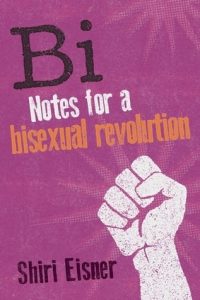Amazon Affiliate Link | Bookshop.org Affiliate Link
While Shiri Eisner’s Bi: Notes for a Bisexual Revolution was published almost 10 years ago, there’s still so much that resonates. This shows how far we still have to go in the bisexual movement, but it also shows how far it’s come.
Right from the introduction, Eisner lays out her own privileges and biases, holding herself accountable and acknowledging her perspective may be incomplete or skewed. It’s impossible to craft a perfect point of view, but it’s important to recognize when one falls short. It gives the reader a chance to fill the gaps that she may have missed or experienced differently.
Before diving into anything, Eisner defines the differences between being liberal and radical. While liberal movements seek to gain power within an established system, radical (stemming from the Latin word for “root”) movements seek to cut out oppression from the root. This sets up the idea of bisexuality as a way for dismantling rather than normalizing.
Eisner delves into the constantly evolving definition of bisexual, how it started as part of a binary, following its nonlinear growth into the multifaceted definition that prevails today. While bisexuality was established in early discourse by cisgender folks, it’s since had to change to adapt to the fluid notions of sex and gender.
Bisexuality is often accused of reaffirming the gender binary, but in fact, it has the potential to subvert these systems. Because of its fluidity and multiplicity, bisexuality can be used as a lens to break down hierarchical binaries of good/bad, true/false, etc. Rather than go through a myth-busting of stereotypes, Eisner leans into what they could mean. For example, the idea of bisexuality being a phase, a common stereotype, opens the door to the idea that sexuality is not fixed and is instead an open-ended and continual process.
The section that felt like it needed another perspective or a strengthened argument was her comparison of bi-erasure to the idea of “passing,” both in how it relates to race and gender expression. She makes a valid point in saying that society tells us appearance equals identity, but this chapter felt like it lacked a deeper understanding, specifically in relation to racial passing.
However, she does point out how bisexuality disrupts the social hierarchy by making it hard for those in power to perceive who is Other, thereby accidentally giving an outsider the same power and privileges as those who participate in oppression. Because it’s the visual cues that alert those in power whom to oppress, and without these cues, they cannot properly implement their oppression.
Eisner covers a lot of ground in the book, so it’s hard to go into detail about every single topic. But the overall concept she pushes for is to use a bisexual revolution to disrupt systems, not make it palatable for the masses. Furthermore, it should work toward creating a world that benefits everyone, not fight for the same privileges as our current oppressors; a true bisexual revolution would not leave anyone behind.

